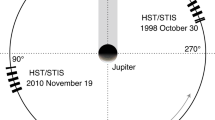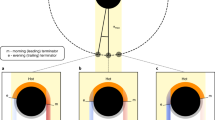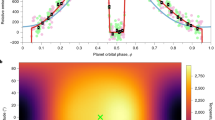Abstract
A GLOW around exposed surfaces of the space shuttle facing the direction of orbital motion was first seen in 19831,2. This 'shuttle glow' extends about 10cm from the surfaces, is peaked in wavelength at 680 nm, and within a resolution of about 3.5 nm forms a continuum3–6. Similar anomalies were reported in rocket experiments as long ago as 19587 and in more recent space-based studies8. Apart from its interest as an unusual physical phenomenon, shuttle glow may be a source of interference in space-based spectroscopy; anomalous airglow observations made by the Atmospheric Explorer spacecraft9,10 have been attributed to it. The most likely explanation seems to be the recombination of fast oxygen atoms in the upper atmosphere with NO absorbed on the shuttle's surface. This forms excited NO2, which radiates light as it desorbs6,7. On a recent shuttle mission (STS-39) four gases, NO, CO2, Xe and Ne were released for a plasma experiment. Unintentionally, enough gas was scattered onto the surfaces of the shuttle tail that when NO was released a much more intense version of shuttle glow was observed. The other gases did not affect the normal shuttle glow. Under normal conditions the adsorbed NO that causes the glow probably comes either from the ambient atmosphere6 or from reactions in exhaust gases from the shuttle thrusters14,15.
This is a preview of subscription content, access via your institution
Access options
Subscribe to this journal
Receive 51 print issues and online access
$199.00 per year
only $3.90 per issue
Buy this article
- Purchase on Springer Link
- Instant access to full article PDF
Prices may be subject to local taxes which are calculated during checkout
Similar content being viewed by others
References
Banks, P. M., Williamson, P. R. & Raitt, W. J. Geophys. Res. Lett. 10, 118–121 (1983).
Mende, S. B., Garriott, O. K. & Banks, P. M. Geophys. Res. Lett. 10, 122–125 (1983).
Green, B. D., Caledonia, G. E. & Wilkerson, T. D. J. Spacecraft Rochets 22, 500–511 (1985).
Murad, E. in Physics of Space Plasmas (1985–1987), Vol. 6 (eds Chang, T. et al.) 147–161 (Scientific, Cambridge, MA, 1987).
Garrett, H. B., Chutjian, A. & Gabriel, S. J. Spacecraft Rockets 25, 321–341 (1988).
Swenson, G. R., Mende, S. B. & Clifton, K. S. Geophys. Res. Lett. 12, 97–100 (1985).
Heppner, J. P. & Meredith, L. H. J. geophys. Res. 12, 51–65 (1958).
Torr, M. R., Hays, P. B., Kennedy, B. C. & Walker, J. C. C. Planet. Space Sci. 25, 173–184 (1977).
Yee, J. H. & Abreu, V. J. Proc. SPIE Tech. Symp. 338 (ed. Maag, C. R.) 120 (SPIE, Bellingham, 1982).
Yee, J. H., Abreu, V. J. & Dalgarno, A. Geophys. Res. Lett. 11, 1192–1194 (1984).
Paulsen, D. E., Sheridan, W. F. & Huffman, R. E. J. chem. Phys. 53, 647–658 (1970).
Swenson, G. R., Mende, S. B. & Meyerott, R. E. Nature 323, 519–522 (1986).
von Zahn, U. & Murad, E. Nature 321, 147–148 (1986).
Meyerott, R. E. & Swenson, G. R. Planet. Space Sci. 38, 555–566 (1990).
Green, B. D., Rawlins, W. T. & Marinelli, W. J. Planet. Space Sci. 34, 879–887 (1986).
Caledonia, G. E. et al. Geophys. Res. Lett. 17, 1881–1884 (1990).
Swenson, G. R., Leone, A., Holtzclaw, K. W. & Caledonia, G. E. J. geophys. Res. 96, 7603–7612 (1991).
Arnold, G. S. & Coleman, D. J. J. chem. Phys. 88, 7147–7156 (1988).
Orient, O. J., Chutjian, A. & Murad, E. Phys. Rev. A41, 4106–4108 (1990).
Murad, E., Lai, S. T. & Stair, A. T. Jr J. geophys. Res. 91, 10188–10192 (1986).
Green, B. D. et al. 26th Aerospace Sciences Meeting Paper AIAA-88-0432 (AIAA, Washington DC, 1988).
Fontijn, A. & Rosner, D. E. J. chem. Phys. 46, 3275–3276 (1967).
Golomb, D. & Good, R. E. J. chem. Phys. 49, 4176–4180 (1968).
Mende, S. B., Swenson, G. R. & Liewellyn, E. J. Adv. Space Sci. 7, 169–178 (1987).
Pickett, J. S., Murphy, G. R., Kurth, W. S., Goertz, C. K. & Shawhan, S. D. J. geophys. Res. A90, 3487–3497 (1985).
Caledonia, G. E., Holtzclaw, K. W., Sonenfroh, D. & Krech, R. in Proc. Workshop on Induced Environment of Space Station Freedom (ed. Torr, M. R.) (NASA, Huntsville, 1990).
Author information
Authors and Affiliations
Rights and permissions
About this article
Cite this article
Viereck, R., Murad, E., Green, B. et al. Origin of the shuttle glow. Nature 354, 48–50 (1991). https://doi.org/10.1038/354048a0
Received:
Accepted:
Issue Date:
DOI: https://doi.org/10.1038/354048a0
Comments
By submitting a comment you agree to abide by our Terms and Community Guidelines. If you find something abusive or that does not comply with our terms or guidelines please flag it as inappropriate.



